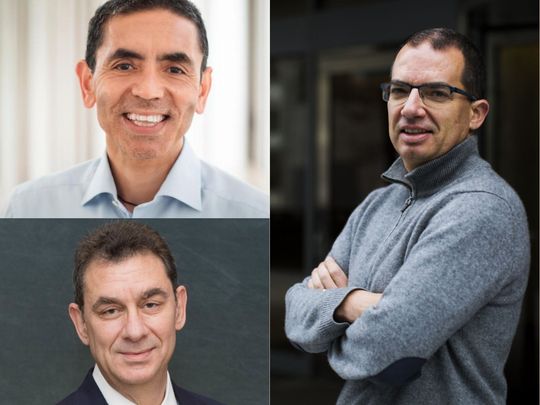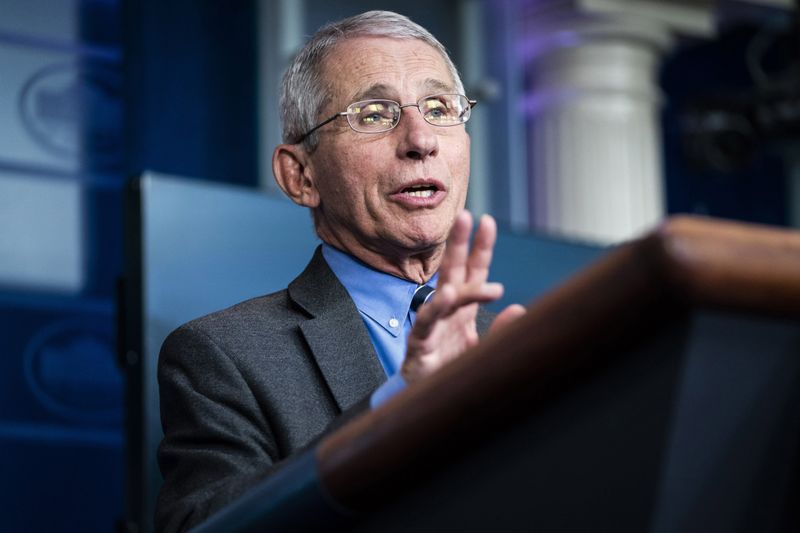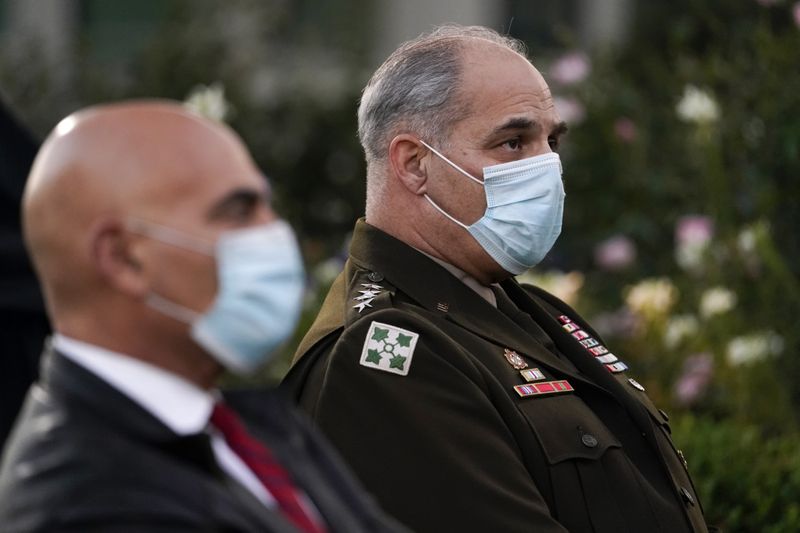
Washington: The call was tense, the message discouraging. Moncef Slaoui, the head of the Trump administration’s effort to quickly produce a vaccine for the coronavirus, was on the phone at 6pm on August 25 to tell upstart biotech firm Moderna that it had to slow the final stage of testing its vaccine in humans.
Moderna’s chief executive, Stephane Bancel, a French biochemical engineer, recognised the implication. In the race to quell the pandemic, he said, “every day mattered.” Now his company, which had yet to bring a single product to market, faced a delay of up to three weeks. Pfizer, the global pharmaceutical giant that was busy testing a similar vaccine candidate and promising initial results by October, would take the obvious lead.
‘Hardest decision’
“It was the hardest decision I made this year,” Bancel said.
Moderna’s problem seemed fitting for late summer 2020, when the United States was reeling from not just a pandemic but unrest over racial injustice. Slaoui informed Bancel that Moderna had not recruited enough minority candidates into its vaccine trials. If it could not prove its vaccine worked well for Black and Hispanic Americans, who have been disproportionately affected by the pandemic, it would not make it over the finish line.
Both companies ultimately completed the crucial stages of their human trials this month and reported spectacular initial results, vaccines that appear to be about 95 per cent effective against a virus that has killed 1.3 million people, a quarter million of them in the United States.
Toxic political atmosphere
Few corporate competitions have unfolded with so much at stake and such a complex backdrop. At play were not just commercial rivalries and scientific challenges but an ambitious plan to put the federal government in the middle of the effort and, most vexingly, the often toxic political atmosphere created by President Donald Trump. Betting that a vaccine would secure his reelection, he waged both public and private campaigns to speed the process.
Few corporate competitions have unfolded with so much at stake and such a complex backdrop. At play were not just commercial rivalries and scientific challenges but an ambitious plan to put the federal government in the middle of the effort and, most vexingly, the often toxic political atmosphere created by President Donald Trump.
Pfizer’s chief executive, Dr. Albert Bourla, had vowed to avoid the political minefield but was forced to manoeuvre through it nonetheless. After promising progress on a timetable that seemed to support Trump’s prediction of a breakthrough before Election Day, Bourla pushed back the schedule in late October, fearing his firm’s clinical trial results would otherwise not be convincing enough for federal regulators to grant emergency approval of its vaccine. News of Pfizer’s success was announced just after the election was called for Joe Biden.
No money
Bourla had chosen from the start to keep Pfizer and its research partner, German firm BioNTech, at arms length from the government, declining research and development money from the crash federal effort, called "Operation Warp Speed".
Bancel, with a far smaller company, made the opposite bet, embracing the assistance of a government led by a science-denying president. Moderna got nearly $2.5 billion to develop, manufacture and sell its vaccine to the federal government and teamed up with the National Institutes of Health (NIH) on the scientific work, a highly successful partnership that managed to sidestep the political meddling by Trump and his aides that had bedeviled other efforts to confront the virus.
Coronavirus: A perfect target
Pfizer and Moderna alone would not meet domestic or global demand, but other companies in the United States and around the world are also rushing toward effective vaccines, some of them using more proven technologies, so other winners are likely to emerge.
Still, both companies, in their own very different ways, have pulled off a remarkable feat: developing a vaccine that appears safe and effective in a matter of months, rather than the years or decades that such developments usually take. They were aided by a confluence of three factors. A new method of developing vaccines was already waiting to be tested, with the coronavirus a perfect target.
Sky-high infection rates accelerated the pace of clinical trials, the most time-consuming part of the process. And the government was willing to spend whatever it took, eliminating financial risks and bureaucratic roadblocks and allowing mass production to begin even before the trials were done.

Their apparent success showed that in an era of polarised politics, science was able to break down barriers between government, countries and industry to produce one of the few pieces of good news in a year of suffering and division.
Revolutionary
Bancel was in Switzerland for a business conference in January when he heard of a deadly new viral outbreak in Wuhan, China. He immediately reached out to two NIH vaccine experts with whom his company had been working for years to develop technology that could be used to design vaccines, a sort of plug-and-play system that would revolutionise how humanity confronts new pathogens.
If the systems worked, designing a vaccine would be done in days. The task remaining would include time-consuming trials to ensure the vaccine worked and was safe, a process that brooked no shortcuts.
Their apparent success showed that in an era of polarised politics, science was able to break down barriers between government, countries and industry to produce one of the few pieces of good news in a year of suffering and division.
Like ‘adding an app’
Unlike older, slower ways of developing vaccines, which involve stimulating the body’s immune system by injecting inactivated or weakened viruses, Moderna and other companies created platforms that work like the operating system on a computer, allowing researchers to quickly insert new genetic code from a virus — like adding an app — and create a new vaccine.
The method employs a synthetic form of a genetic molecule called messenger RNA, or mRNA, to cause human cells to make a harmless viral protein called a spike, which then stimulates the immune system to make antibodies and immune cells that can recognise the spike quickly and counterattack when needed.
Earlier efforts to test new types of vaccines in outbreaks like SARS, MERS and Zika had fizzled when the threat from those viruses receded, before large clinical trials could be carried out. But the outbreak spreading in China had the hallmarks of a prolonged pandemic, a tragedy but also a perfect testing ground for the new biotechnology.
‘Warrior personality’
Bancel, 48, had what one former colleague described as a “warrior personality.” He had left a much bigger firm to become chief executive at Moderna in 2011, warning his wife that the firm’s mRNA bet had a 5 per cent chance of success. But if that bet paid off, he told her, it would change the course of medicine.
In late 2019, he said, the Vaccine Research Center at NIH agreed to stage a war game of sorts the following spring, a mock pandemic with a virus unknown to Moderna to see how quickly the company could come up with a vaccine. Now, with an actual pandemic at hand, Bancel wanted to try out Moderna’s approach for real.
‘No exit on this highway’
Some Moderna executives suggested taking a stab at a vaccine for a few months, then reassessing. But Juan Andres, the company’s chief technical operations and quality officer, said he warned: “Sorry, guys, there is no exit on this highway. If we are in, we are in.”
NIH got in with them. Dr. John R. Mascola, the head of the Vaccine Research Center, and Dr. Barney Graham, the center’s deputy director, proposed the partnership to Dr. Anthony Fauci, the director of the National Institute of Allergy and Infectious Diseases.

“Go for it,” Fauci said he told them. “Whatever it costs, don’t worry about it.” Moderna’s goal was to get from a vaccine design to a human trial in three months. The design came quickly. “This is not a complicated virus,” Bancel said.
Two days
Graham said that after China released the genetic sequence of the new virus, the vaccine research centre zeroed in on the gene for the virus’ spike protein and sent the data to Moderna in a Microsoft Word file. Moderna’s scientists had independently identified the same gene. Bancel said Moderna then plugged that data into its computers and came up with the design for an mRNA vaccine. The entire process took two days. NIH scientists were “really hot” on the mRNA approach, Fauci said. But it was not Moderna’s alone.
Husband-wife team
In Germany, husband-and-wife scientists Dr. Ugur Sahin and Dr. Ozlem Tureci were on the same path. Their firm, BioNTech, had been working with Pfizer for several years to develop a new flu vaccine with the same mRNA technology that Moderna was using. Sahin said he asked a Pfizer executive on March 1 if the company wanted to chase a coronavirus vaccine.
Bourla, Pfizer’s top executive, conceded that when the virus first emerged, he "wasn’t under the impression at the time that this would become a major global issue that would require a major intervention from us."
Born in Greece, a veterinarian by training, he had worked his way up over more than two decades from Pfizer’s animal health division to the chief executive’s office in 2019. Initially, the 59-year-old executive was mostly focused on protecting the company’s 90,000 employees in locations around the world.
But once he learned of the Germans’ proposal, he and his company moved quickly. Pfizer agreed to front BioNTech’s development costs and manage the clinical trials, manufacturing and distribution. BioNTech agreed to pay Pfizer back out of any profits, which would be split.
Gravest public health crisis
As the economy shuddered to a halt last spring and deaths mounted in New York, Detroit and Chicago, administration officials proposed a coordinated effort to develop tests, treatments and vaccines for what was now clearly the gravest public health crisis in a century.
Operation Warp Speed was the brainchild of Dr. Peter Marks, the top vaccine regulator for the Food and Drug Administration. A collaboration between the Pentagon and the Department of Health and Human Services, it was devised to support pharmaceutical and biotechnology companies with the full breadth of the government’s expertise from clinical trials to logistics. The goal for a vaccine was October, according to an early memo.
The president was especially enthusiastic about that aim. At a March 2 White House meeting, as Bancel and other pharmaceutical executives outlined their vaccine plans, Fauci cautioned that it would be a “year to a year and a half” before doses could reach the broader public.
Trump replied, “I like the sound of a couple of months better.” Warp Speed had two leaders. In charge of science was Slaoui, who had led research and development at drugmaker GlaxoSmithKline for years and had served on Moderna’s board of directors. In charge of logistics was Gen. Gustave F. Perna, a four-star general who led the Army Materiel Command.

Battle rhythm
The operation, working out of a seventh-floor suite and a second-floor operations center at the Health and Human Services headquarters, had a military flavor. Its leaders discussed the book “Freedom’s Forge,” an account of how American industry armed the military in World War II, and imposed what they called a “battle rhythm” of meetings, including a daily 8am session on vaccines. Dozens of military officers reported to work in uniform.
The biggest decision, Slaoui said, was which vaccine candidates to back out of almost 50 possible contenders. His team decided on three types of vaccines, each to be pursued by two companies in case one firm failed. Federal officials referred to the finalists as “horses,” a nod to the race between them.
Moderna and Pfizer would pursue the mRNA vaccines, seen as the fastest to develop. The government was ready to foot much of the development bill, guide the clinical trials and even deliver supplies to factories. Bourla was not interested. As one of the world’s top vaccine producers, Pfizer did not need federal help in developing a new product, he decided, and with nearly $52 billion in annual revenues, it did not need or want the subsidy.
On its own
Pfizer signed a $1.95 billion agreement in July to sell the federal government 100 million doses of its vaccine if it was successful, guaranteeing it a buyer, no small incentive. It also called on the Trump administration a few times to get access to manufacturing supplies. Otherwise it was on its own.
Moderna had no qualms about government help. “Guys, we don’t have a balance sheet like Pfizer,” Bancel said he told federal officials.
Nearly $2.5 billion in federal funds helped Moderna buy raw materials, expand its factory, and enlarge its workforce by 50 per cent. In return, it promised to deliver 100 million doses to the federal government.
Guidelines
By early fall, political pressures that had been building all year burst into the open. Federal regulators were trying to issue guidelines to ensure enough follow-up of clinical trial participants to make sure the vaccines were safe, but White House officials were blocking them. The president was attacking FDA officials as antagonists intent on thwarting his re-election.
Bourla had been dragged into the political thicket, in part because of his own promises that Pfizer expected clinical trial results by October. The president ballyhooed that deadline on the campaign trial and tried to publicly link himself to Pfizer’s leader.
Sahin, of BioNTech and Pfizer’s partner, said Bourla was trying to manage “an uncomfortable situation.” But when the president went after the FDA, Bourla drew a line, deciding that public confidence in a vaccine was at stake. “We had statements against the FDA, the deep state, et cetera, that really were concerning for me,” he said. “We needed to speak up.”
He called Alex Gorsky, the chief executive of Johnson & Johnson, another leading contender in the vaccine race, then recruited leaders from other companies. Together, they drafted a statement that said the industry would “stand with science” and follow FDA guidelines. By September 8, nine companies, including Moderna, had signed on.
44,000
number of volunteers in the Pfizer trial, expanded from the initial 30,000At the same time, hitches in the design and execution of the clinical trials were emerging. Both Pfizer and Moderna were facing the problem of too few minority volunteers, but Pfizer had the deep pockets to solve it. The firm expanded its trial from 30,000 to 44,000, a decision that Dr. Eric Topol, a clinical trial expert with Scripps Research in La Jolla, California, estimated cost the firm hundreds of millions of dollars.
More minorities
When Slaoui from Operation Warp Speed called Moderna’s chief executive to say Moderna had to recruit more minorities, it came as a body blow. Slaoui told a colleague afterward: “I just burned all our relationship” with Moderna.
In a double-blind clinical trial, the gold standard for testing new medicines or vaccines, neither the company nor the participants know who receives vaccines and who gets placebos. Only an independent review board has access to that information.
Fauci met with Moderna’s trial investigators and enlisted NIH experts to help the company reach more Black and Hispanic volunteers. While Moderna won plaudits for diversifying its pool, Pfizer, whose trial was already designed to reach a result quicker than Moderna’s, was now indisputably ahead. But Pfizer faced its own crisis.
In a double-blind clinical trial, the gold standard for testing new medicines or vaccines, neither the company nor the participants know who receives vaccines and who gets placebos. Only an independent review board has access to that information.
The protocols for the trials lay out under what conditions the board can look at the results. Pfizer’s trial protocol was the most aggressive of all six vaccine candidates, allowing for a check of interim results once 32 participants developed COVID-19.
It was a lower bench mark than Moderna and the other companies had adopted and FDA regulators warned Pfizer they were highly unlikely to issue an emergency use authorisation for a coronavirus vaccine based on such a small data set. Outside experts criticised Pfizer for allowing itself to peek at the data too early and too often.
Election Day
Pfizer decided it should drop that first bench mark and asked the FDA to approve a new protocol on October 29, effectively dashing Trump’s hopes of an announcement before Election Day. The company also stopped processing test results from trial participants while it worked with the FDA. Protocol changes are discouraged once data is available, and Pfizer did not want to cross the bench mark before it got verbal approval to drop it. That approval came on November 3, Election Day, or the day after.
Conspiracy
The delay later enraged Trump, who claimed it was part of a conspiracy to damage his chance at reelection. Bourla said he turned a blind eye to the Election Day deadline.
“Before, people were saying it’s too soon,” he said. After the election, “people are saying, ‘Oh, it’s too late.’”
Once Pfizer resumed processing test swabs on Nov. 4, it quickly became apparent that the infection rate had skyrocketed, as it had nationwide and in other countries. With 94 COVID-19 cases, the company asked the data monitoring board to reveal the results.
Verdict
On Sunday morning, November 8, Bourla headed to Pfizer’s office in Cos Cob, Connecticut, to hear the verdict with a few top aides. “I couldn’t sleep very much,” he said. A Pfizer statistician, who was walled off from the rest of the company, was to deliver the news from the data monitoring board in a video conference.
“We had a very good result,” the man announced in the early afternoon. He said Pfizer should immediately ask the FDA to grant it emergency use authorization, a step the firm took Friday.
The room erupted in cheers. Executives hugged, ignoring social distancing rules. Moderna had to watch Pfizer cross the finish line first. But Pfizer’s results buoyed the company’s hopes.
Last Sunday, expecting the results from Moderna’s trial, Bancel closeted himself in a home office in his Boston town house. “I’m going to be totally a wreck the whole day,” he told his wife.
Eleven volunteers had developed severe illness, the voice said. Then came a pause that Bancel said “felt like forever,” before the final word: Every one of them had gotten the placebo.
Just after noon, a notice shot across Moderna’s secure chat system to join a virtual meeting. With about a dozen other members, Bancel listened to the flat, disembodied voice of a representative from the outside panel. The results were remarkably like Pfizer’s: Out of 95 infections, 90 were in the placebo group and five in the vaccine group. Then the outside panel broke down the cases by severity of illness, a critical measure of the vaccine’s potency.
Crying
Eleven volunteers had developed severe illness, the voice said. Then came a pause that Bancel said “felt like forever,” before the final word: Every one of them had gotten the placebo.
He ducked out into the hallway to tell his wife. His 19-year old daughter raced down from the second floor. His 16-year-old flew up the basement stairs.
“The four of us were crying,” he said.








